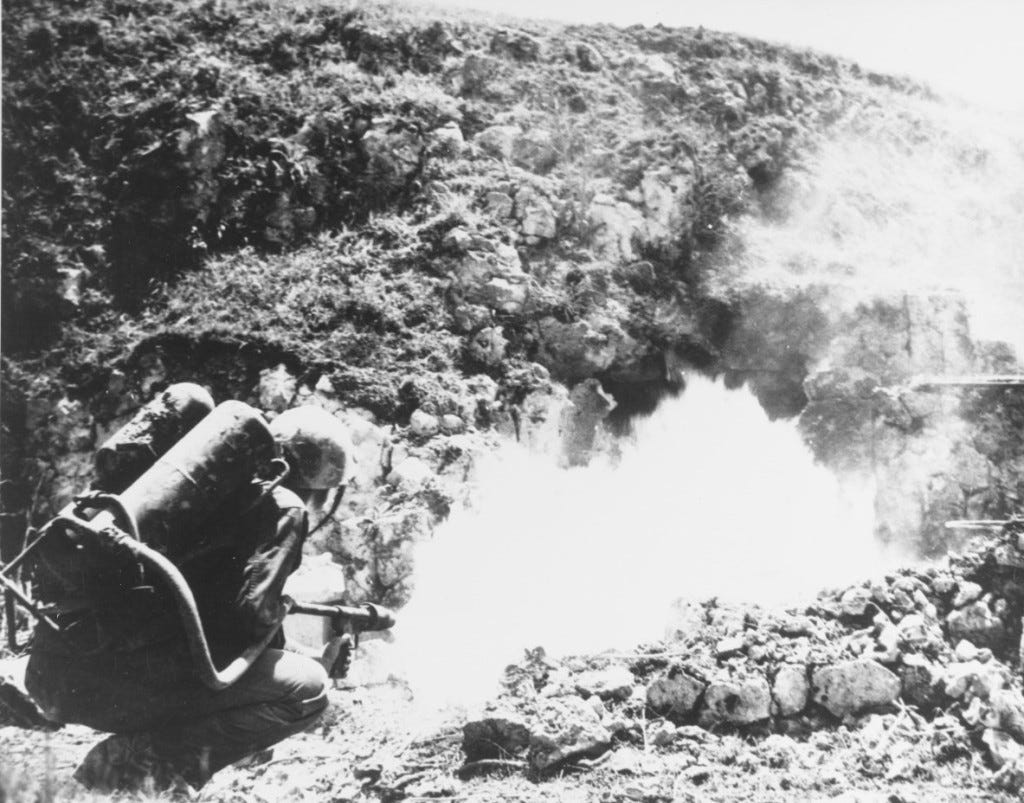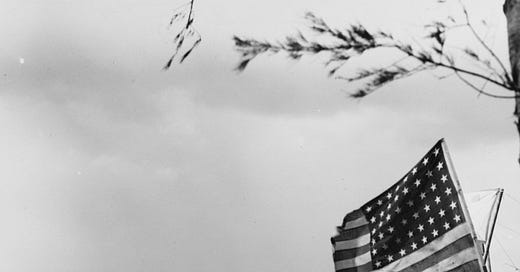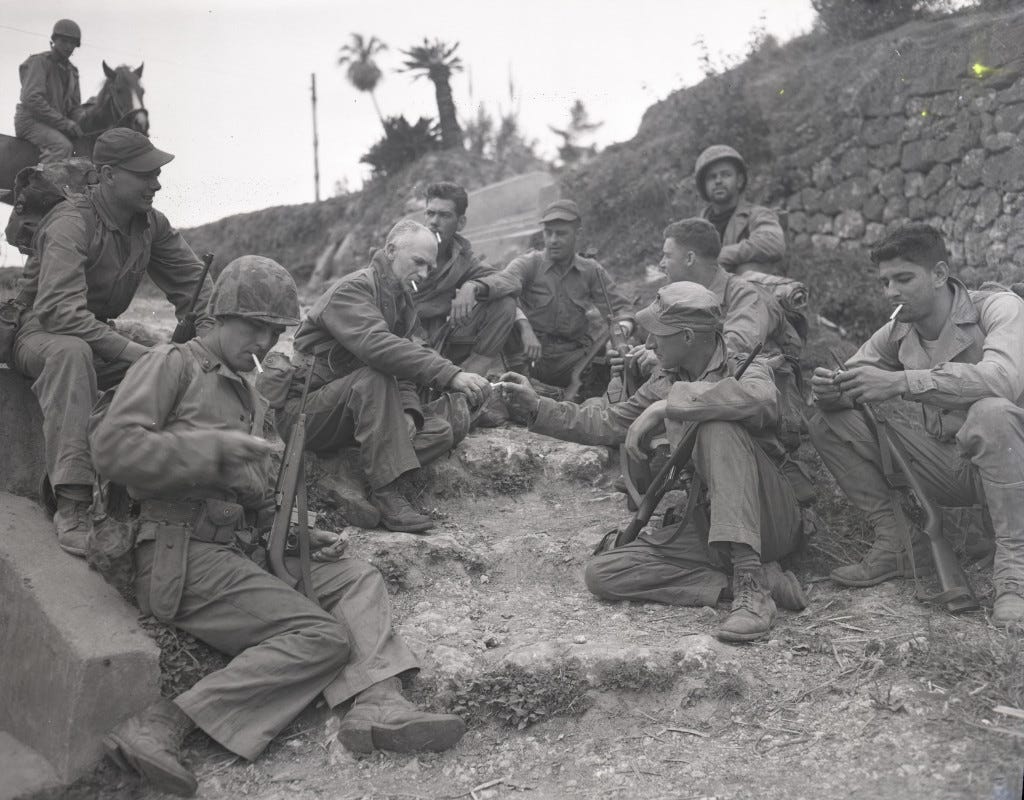Okinawa: The 'easy' victory that wasn't
Writing from the shore of Okinawa on April 1, 1945, New York Times correspondent George E. Jones was incredulous while maintaining a touch of skepticism.
The first three paragraphs of his front-page story about the initial U.S. landings on the island used the words “unfathomable” and “astounding” as he and the rest of the invaders marveled at the utter lack of opposition. But Jones wasn’t quite ready to believe it could be this easy.
The Japanese simply refused to fight for the beachhead and instead retired for purposes as yet dark and inscrutable.
It is considered very likely there will be counterattacks that will employ artillery in succeeding days. But the beachhead is ours. Within an hour and fifteen minutes after the first assault which hit the beach, the first Sherman tanks rolled ashore and by early afternoon marine artillery began coming in. In contrast to bloody Iwo Island, the beach was free of the usual invasion litter, such as helmets, K ration cartons, life jackets — and intermingled bodies of invader and defender.
Marine Corps Maj. Gen. Roy S. Geiger, who along with the rest of his men had steeled themselves for what they expected to be their bloodiest fight yet, was just as dumbstruck as he walked around the apparently abandoned island.
“Goddamn — this is April Fool’s Day, all right,” he told Jones.
The situation on Okinawa would indeed get worse — almost unimaginably so — compared to the tranquil scene that greeted the U.S. Army and Marine troops that came ashore that Easter Sunday.
Veteran American troops and observers knew it would. An objective this close to the Japanese home islands would not be secured without a fight from a cornered nation whose troops had all but refused to surrender at Iwo Jima and other outposts on the long slog across the Pacific.
Ernie Pyle was a newcomer to the theater but all too wise in the ways of war and fully aware of Japan’s mindset and capabilities. His initial dispatch from the island was an exercise in ensuring the invaders didn’t believe their first impression constituted the reality that awaited them in the days and weeks to come.
You wouldn’t believe it. And we don’t either. It just can’t be true. And yet it is true.
The regiment of marines that I am with landed this morning on the beaches of Okinawa and were absolutely unopposed, which is indeed an odd experience for a marine. Nobody among us had dreamed of such a thing. We all thought there would be slaughter on the beaches. There was some opposition to the right and to the left of us, but on our beach nothing, absolutely nothing.
We don’t expect this to continue, of course. A marine doesn’t fool himself like that. Certainly there will be hard fighting ahead and we all have our fingers crossed. But to get the firm foothold we have, with most of our men ashore and our supplies rolling in, is a gift for which we are grateful.
Pyle noted that he had come ashore in the seventh wave of landings; correspondents were forbidden to arrive before the fifth wave. As usual, the 44-year-old wrote openly about his apprehension over what awaited him on shore.
I had dreaded the sight of the beach littered with mangled bodies. My first look up and down the beach was a reluctant one. And then like a man in the movies who looks and looks away and then suddenly looks back unbelieving, I realized there were no bodies anywhere — and no wounded. What a wonderful feeling!
The longtime chronicler of Pacific fighting, Robert Sherrod, wrote in Time that the soldiers and marines who headed ashore that Sunday faced only “slightly more opposition than they would have had in maneuvers off the coast of California,” and he was just fine with that.
“This was the kind of invasion every correspondent who knew the marines had wanted to cover,” he wrote. “Those who had been at Iwo Jima were sick of blood, sick of seeing almost every friend killed or wounded.”
Gene Sherman of the Los Angeles Times hadn’t seen nearly as much war as Pyle and Sherrod had, and the tone of his initial report from a patrol boat offshore was different, almost tinged with disappointment.
It is past noon as I write this — about four hours after the initial waves of soldiers and marines landed — and we are wondering why it is now so quiet. Silence hangs strangely in the air, a tremendous contrast, even a let-down, after the shattering thunder of the bombardment.
At the end of his story, Sherman speculates that the pre-invasion bombardment and waves of troops storming ashore “may have sapped the Jap defenses, to say nothing of their morale,” and suggests they simply might not “have the resistance to offer.”
This bit of wishful thinking took root well beyond the beachhead, as readers back home took the universally positive initial reports and projected a clear and imminent path to victory. The editorial page of the Pasadena Star-News on April 2 — mere hours after the initial landings — included an item headlined “Okinawa is Major Victory.”
Sherman’s paper followed the thread even further, unspooling a string of speculation that looks ridiculous in hindsight. Under the headline “Invasion of Okinawa an Amazing Exploit,” the Times wrote in part:
It seems possible to hope that the Japs have been badly outguessed again, that their troops on Okinawa are far from their best either in quality or equipment, and that the conquest of this valuable prize may not cost many American lives.
Correspondents on the ground perpetuated the idea that the operation would be a walkover for the next few days. On April 4, William McGaffin of the Chicago Daily News weighed in with a piece on the friendly and accommodating nature of the Okinawans who greeted the landing forces — one of several such stories filed by reporters on the scene.
McGaffin’s story began:
The civilians of Okinawa are friendly.
That has been our experience to date with the hundreds, who are coming into our lines, bowing respectfully, with grave faces that break into smiles when we smile at them.
It is my guess that the docile attitude of the 1,200 or more whom I saw this afternoon in one division reception camp along the way will be typical of the entire civilian population here.
Within a few days, though, the tone of the reporting began to shift. Perhaps those initial impressions were indeed too good to be true.
Washington Post correspondent Shirley Povich, some 20 years into his astonishing 75-year run with the paper, sounded a note of alarm in a front-page dispatch datelined April 8. The headline read “‘Easy’ Okinawa Fight Becomes Bitter as Iwo”.
The battle for Okinawa’s southern half into which Army divisions of the Twenty-fourth Corps have hemmed thousands of Jap troops now apparently threatens to develop bitter resistance on an Iwo Jima scale.
American forces who turned south and progressed easily for 8 miles along both coasts after their unopposed landings are now measuring their advances by hundreds of yards. …
Organized Japanese defenses superior to any encountered in the Philippines slowed the Yank troops today. The Japanese apparently withdrew great masses of guns and material from the central part of the island to defend the south.
The following day, the commander of the combined army and marine ground forces, Lt. Gen. Simon Bolivar Buckner, made the direct comparison to Iwo Jima in an interview with correspondents.
William Marien of the Sydney Morning Herald offered up this assessment from Buckner in an April 9 story:
The general predicted that the fighting would continue to gain in intensity during our drive south until the back of Japanese resistance was broken, when the struggle would develop into a rout.

One could argue that Buckner got it right, eventually, but he never could have imagined what it would take to get to that point. When the Americans officially declared victory on Okinawa two and a half months later, the entire landscape of the Second World War had changed dramatically.
By the time the flag-raising ceremony was held on June 22, the fighting in Europe had been finished for six weeks and U.S. scientists were only about three weeks from testing the secret weapon that would end the war and change the world.
Buckner was dead, killed just four days earlier by artillery fire. So were three men who had led their countries into the war years earlier — Mussolini, Hitler and Roosevelt. So was Ernie Pyle.
Beyond the well-known names, the carnage on Okinawa was staggering. Though firm casualty figures are difficult to ascertain, the death toll includes between 14,000 and 20,000 Americans, more than 75,000 Japanese troops, and tens of thousands of Okinawans — perhaps as many as half of the island’s pre-war population of around 300,000.
We know now that Okinawa would be the final large-scale battle of the war, but in the summer of 1945 everyone on all sides assumed a ground invasion of Japan was inevitable. Taking stock of the costly victory, the New York Times editorial board wondered in its June 25 editions about what Japanese resistance on this stepping-stone island would mean in the big picture.
There are two ways of viewing the victory on Okinawa. One is to assume that if we could take this island fortress, held by the best army Japan could assemble, we can take any position the Japanese attempt to defend.
The other lengthens the prospect of final victory over the enemy. If it took almost three months to conquer Okinawa, how much life, treasure and time must we expend to conquer Kyushu and Honshu? From either viewpoint the cost of the conquest is sobering. It makes the invasion of Japan seem no less hazardous than the invasion of Europe.
After a long paragraph of hopeful speculation noting that the battlefield situation around the home islands could prove different and more advantageous to the Allies, the piece concludes:
Okinawa warns us to prepare for the worst. If we do so we can hope for the best.





